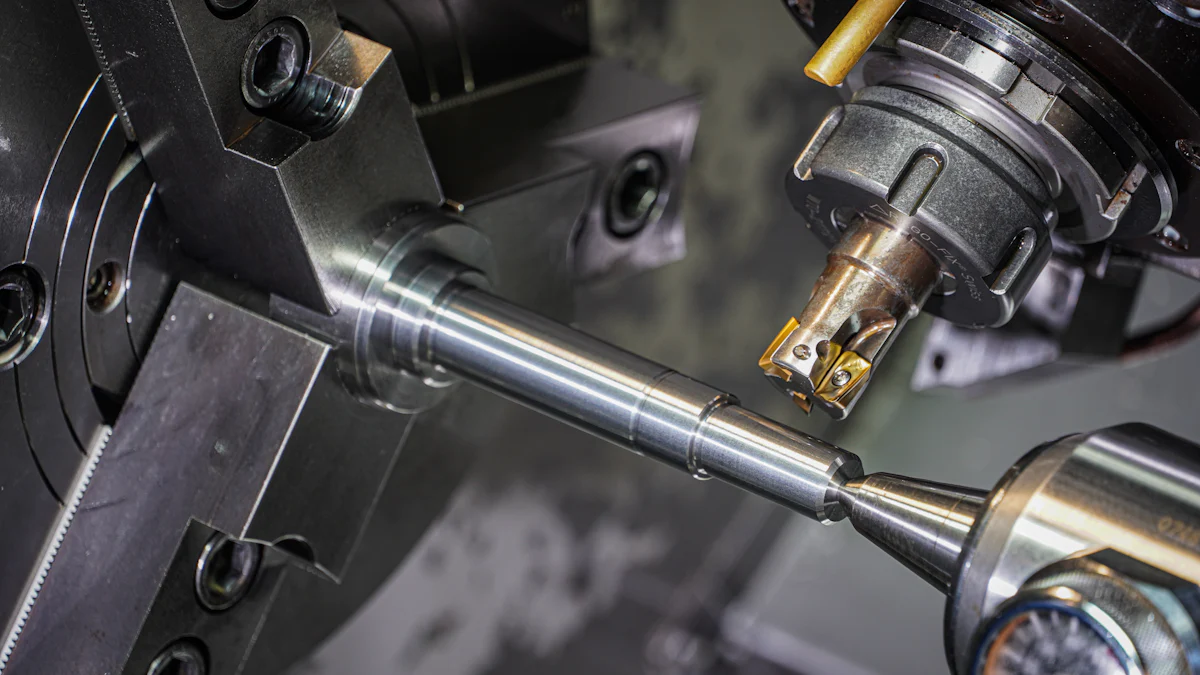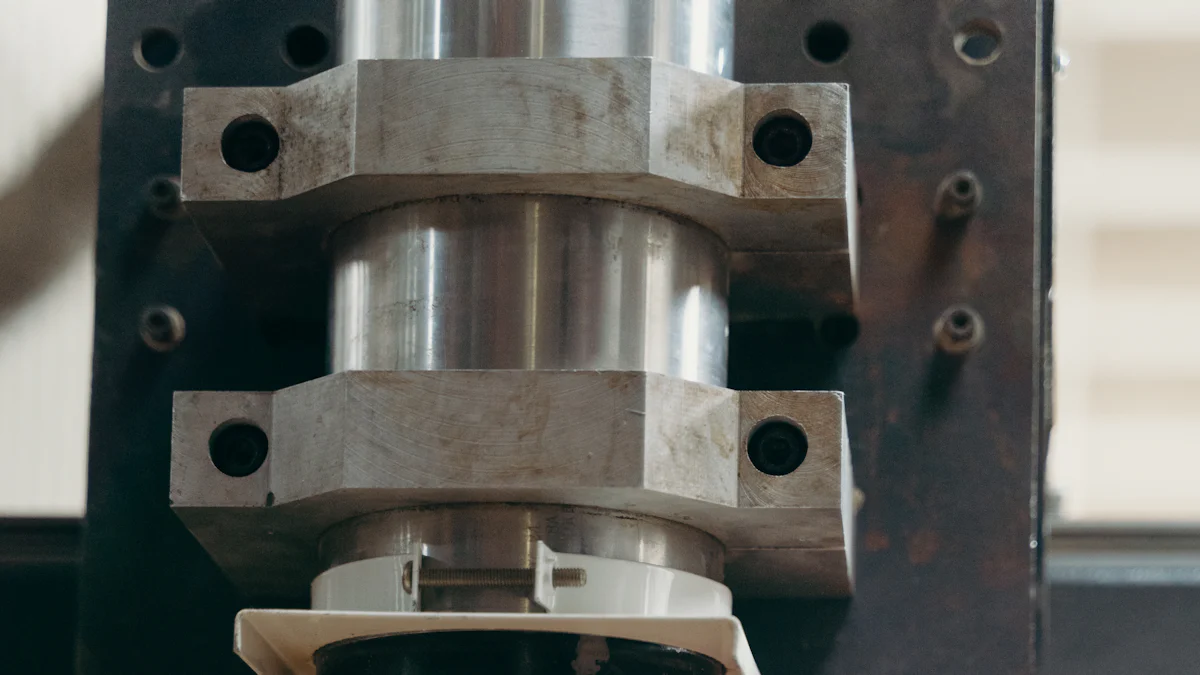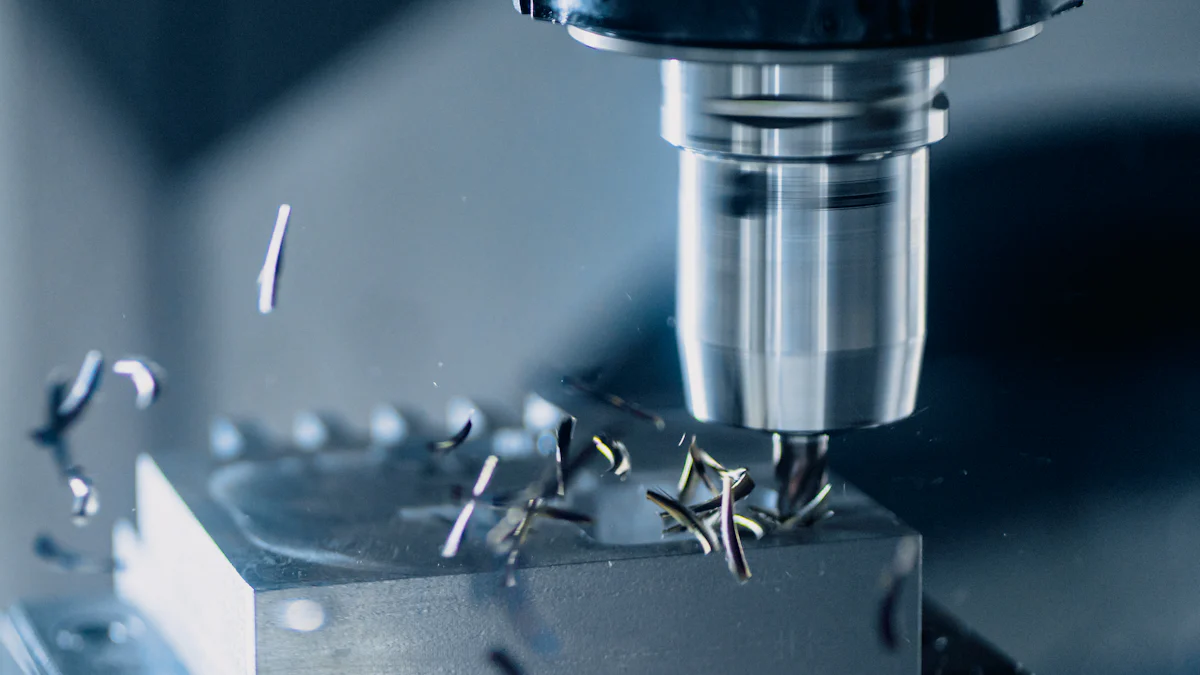Understanding the Different Types of CNC Cutting Tools

CNC cutting tools play a vital role in precision machining, enabling you to achieve accurate and efficient results. These tools come in various types, each designed for specific tasks. Common examples include end mills for versatile material removal, slab mills for flat surfaces, and thread mills for threading operations. Selecting the right cnc cutting tool depends on factors like material type, tool geometry, and cutting speed. Proper choices ensure durability, precision, and cost-effectiveness, making cutting tools indispensable for high-quality machining.
End Mills in CNC Machines

Overview of End Mills
Design and Features of End Mills
End mills are versatile cutting tools used in CNC machines for a wide range of machining tasks. Their design sets them apart from other types of tools. Key features include cutting geometry, helix angle, material, and coating. These features determine how well the tool performs in different applications.
Feature | Description |
|---|---|
Cutting Geometry | Influences suitability for various machining operations and material types. |
Helix Angle | Affects cutting efficiency, chip formation, and heat dissipation during machining. |
Material | Directly influences cutting performance, durability, and types of materials that can be machined. |
Coating | Enhances performance, increases durability, and extends lifespan of the end mills. |
The cutting geometry and helix angle play a critical role in ensuring smooth operations. Materials and coatings improve durability and extend the tool's lifespan, making them ideal for demanding tasks.
Common Materials Used in End Mills
End mills are often made from high-speed steel (HSS), carbide, or cobalt. HSS offers affordability and toughness, while carbide provides superior hardness and heat resistance. Cobalt end mills strike a balance between durability and cost. These materials allow you to machine metals, plastics, and composites effectively.
Applications of End Mills
Slotting, Profiling, and Contouring
End mills excel in tasks like slotting, profiling, and contouring. Slotting involves cutting narrow slots into a workpiece, while profiling allows you to create complex shapes and profiles. Contouring is perfect for crafting intricate surface designs. Industries like automotive, aerospace, and electronics frequently use end mills for these purposes.
Industry | Application Types |
|---|---|
Automotive | Slotting, Profiling |
Aerospace | Slotting, Profiling |
Electronics | Slotting, Profiling |
General Manufacturing | Slotting, Profiling |
Pocketing and Complex Shape Creation
End mills are also ideal for pocketing and creating complex shapes. They provide high precision, making them suitable for intricate parts in aerospace and automotive industries. Their compatibility with various materials ensures flexibility for different projects. Additionally, they streamline manufacturing by performing multiple cuts, such as slotting and contouring, in one operation.
Benefit | Description |
|---|---|
Precision | High precision and control for intricate and detailed parts, crucial in industries like aerospace and automotive. |
Compatibility | Works with various materials, providing flexibility for different projects. |
Efficiency | Produces complex parts faster than traditional methods, reducing production time and costs. |
Versatility | Capable of various cuts (slot cuts, profiling, contouring), streamlining the manufacturing process. |
End mills are indispensable for CNC machines, offering versatility and efficiency for a variety of machining tasks. Their ability to handle complex operations makes them a valuable cnc cutting tool in modern manufacturing.
Drills as CNC Cutting Tools
Overview of Drills
Drills are essential cutting tools in CNC machines, specifically designed for creating holes in various materials. Unlike other types of tools, such as end mills or face mills, drills focus solely on hole-making tasks. This specialization makes them indispensable for applications requiring precision and efficiency. While milling operations involve removing material to create complex shapes, drilling ensures straight, accurate holes.
Types of Drill Bits for CNC Machines
Drill bits come in various designs to suit different materials and applications. Twist drills are the most common and versatile, ideal for general-purpose drilling. For harder materials like steel, cobalt or carbide-tipped bits offer durability and heat resistance. Masonry drill bits, often carbide-tipped, are perfect for concrete and stone. Specialized bits, such as diamond-tipped ones, handle delicate materials like glass.
Materials and Coatings for Drill Bits
The material and coating of a drill bit significantly impact its performance. Common materials include high-speed steel (HSS), cobalt steel, and carbide. HSS is affordable and works well for softer materials, while cobalt steel offers better heat resistance for harder metals. Carbide is the hardest and most durable, ideal for heavy-duty machining.
Material Type | Properties | Applications |
|---|---|---|
High-Speed Steel | Durable, withstands high heat levels, suitable for heavy-duty machining. | Heavy-duty machining |
Cobalt Steel | More heat and wear-resistant, longer tool life, can run 25% faster. | Harder metals and softer materials |
Carbide | Hardest and strongest, best for hard and abrasive materials. | Heavy-duty machining |
Coatings further enhance performance. Titanium Nitride (TiN) coatings improve hardness and reduce friction, while Titanium Carbonitride (TiCN) offers even greater durability. Oxide coatings, though less durable, help retain cutting lubricants.
Applications of Drills
Hole-Making in Metals, Plastics, and Other Materials
Drills excel at creating precise holes in a wide range of materials. In the aerospace industry, they ensure accurate holes for fastening and airflow management. Automotive manufacturers rely on drills for engine parts and assembly. In electronics, drills create holes in circuit boards for mounting components. These tools also play a vital role in medical, construction, and energy sectors, where precision and reliability are critical.
Aerospace Industry: Precise holes in aircraft components.
Automotive Industry: Accurate holes for engine parts.
Electronics: Circuit board drilling for mounting components.
Medical Industry: Surgical instruments and implants.
Construction: Structural elements for buildings.
Deep Hole Drilling and Precision Hole Creation
Drilling CNC machines are designed for deep, accurate holes. These machines use specialized drill bits to achieve depths far greater than the bit's diameter. Advanced features like chip removal and coolant flow management ensure stability and precision. This capability is crucial for industries like energy and manufacturing, where deep holes in turbines or piping require exceptional accuracy.
Drills are a vital CNC cutting tool, offering unmatched precision for hole-making tasks. Their versatility and efficiency make them indispensable in modern machining processes.
Turning Tools for CNC Machines
Overview of Turning Tools
Turning tools are essential cutting tools used in CNC machines for shaping cylindrical parts. These tools rotate the workpiece while a stationary cutting tool removes material to achieve the desired shape. Turning tools excel in creating precise external and internal features, making them indispensable in industries requiring high accuracy.
Types of Inserts for Turning Tools
Turning tools use replaceable inserts to perform cutting operations. These inserts come in various shapes, such as triangular, square, and round, each suited for specific tasks. Carbide inserts are the most common due to their durability and heat resistance. Ceramic and diamond-tipped inserts are also available for machining harder materials. Inserts often feature coatings like titanium nitride to enhance wear resistance and extend tool life.
Tool Holder Designs for Turning Operations
Tool holders secure the inserts and ensure stability during machining. Common designs include straight shank holders for external turning and boring bars for internal operations. Quick-change tool holders improve efficiency by reducing setup time. Proper tool holder selection ensures precision and minimizes vibration, which is crucial for achieving smooth finishes.
Characteristic | Description |
|---|---|
Precision and Accuracy | CNC turning tools provide high precision and accuracy, ensuring adherence to tight tolerances. |
Versatility | They can handle various materials, making them suitable for diverse machining applications. |
Efficiency and Speed | These tools operate quickly, enhancing productivity and reducing lead times. |
Complex Geometries | They can create intricate shapes that are challenging for traditional methods. |
Reduced Scrap Rates | Their precision minimizes errors and waste, promoting resource efficiency. |
Automation Benefits | CNC tools operate automatically, allowing operators to focus on other tasks, improving overall efficiency. |
Applications of Turning Tools
External Turning and Facing
Turning tools are widely used for external turning and facing operations. External turning removes material from the outer surface of a workpiece, while facing creates flat surfaces on the ends. Industries like automotive and aerospace rely on these operations to produce engine parts, transmission components, and precision aircraft parts. The medical industry uses turning tools to craft surgical instruments and implants with biocompatible materials.
Automotive Industry: Engine parts, transmission components, and brakes.
Aerospace Industry: Precision components for aircraft and rockets.
Medical Industry: Surgical instruments and implants.
Military and Defense Industry: Custom vehicles and precision equipment.
Internal Boring and Grooving
Turning tools also excel in internal boring and grooving. Boring enlarges existing holes, while grooving creates channels or recesses inside a workpiece. These operations are critical for manufacturing parts like hydraulic cylinders, bushings, and pipe fittings. Industries such as energy and industrial automation depend on these tools for producing components with intricate internal features.
Industry | Application Description |
|---|---|
Industrial Automation | Producing parts for industrial automation and robotics. |
Aerospace and Defense | Crafting components for aerospace and defense applications. |
Precision Tools | Manufacturing high-precision cutting tools and fixtures. |
Automotive | Creating bespoke components for specialized automotive applications. |
Energy Sector | Machining parts for oil and gas, and renewable energy industries. |
Turning tools are versatile and efficient, making them a vital cnc cutting tool for various industries. Their ability to handle complex geometries and diverse materials ensures their importance in modern machining processes.
Milling Cutters in CNC Cutting Tools

Overview of Milling Cutters
Milling cutters are versatile cutting tools used in CNC milling machines to shape and remove material from workpieces. Unlike other types of CNC machines, these cutters can cut in multiple directions, making them ideal for creating complex geometries. They come in various shapes and sizes, each tailored for specific tasks like face milling, slotting, or heavy material removal. High-speed steel (HSS) is a common material for milling cutters due to its toughness and resistance to heat, making it suitable for machining both ferrous and nonferrous metals.
Face Mills for Flat Surfaces
Face mills are designed to create exceptionally flat surfaces with high dimensional accuracy. These tools feature replaceable cutting edges, allowing you to achieve a polished finish on workpieces. Face mills excel in both roughing and finishing stages, offering efficient material removal rates. Their versatility makes them suitable for a wide range of materials and applications, from automotive parts to aerospace components.
Slab Mills for Heavy Material Removal
Slab mills are ideal for heavy-duty operations that require removing large amounts of material. These tools are commonly used in CNC milling machines for machining flat surfaces on large workpieces. Their robust design ensures durability and efficiency, even under high-speed cutting conditions. Slab mills are particularly useful in industries like construction and heavy machinery, where precision and strength are essential.
Applications of Milling Cutters
Surface Finishing and Smoothing
Milling cutters, such as face mills and fly cutters, are perfect for achieving smooth and polished surfaces. Face mills provide exceptional flatness, making them indispensable for precision applications. Fly cutters, on the other hand, are ideal for making shallow or broad cuts, ensuring a high-quality surface finish. These tools are widely used in industries like electronics and medical manufacturing, where surface quality is critical.
High-Volume Material Removal
For high-volume material removal, slab mills and hollow mills are your go-to tools. Slab mills handle heavy-duty operations, while hollow mills excel at creating form radii and full points on workpieces. High feed machining with these tools allows for faster material removal rates, reducing machining time and costs. Lower approach angles and optimized heat dissipation further enhance efficiency, making these tools essential for large-scale production in industries like automotive and energy.
Milling cutters are indispensable in CNC router machines and other types of CNC machines. Their ability to handle diverse tasks, from surface finishing to heavy material removal, ensures their importance in modern machining processes.
Specialty CNC Cutting Tools
Overview of Specialty Tools
Specialty CNC cutting tools are designed for unique machining tasks that standard tools cannot handle effectively. These tools offer unmatched precision and versatility, making them essential for intricate operations. Their advanced features, such as high rigidity and low thermal deformation, ensure superior performance in demanding applications.
Thread Mills for Threading Operations
Thread mills are specialized tools used for creating internal and external threads in workpieces. Unlike taps, a single thread mill can produce threads of various diameters and types, including left-hand and right-hand threads. This versatility reduces the need for multiple tools. Thread mills also require less power and torque, minimizing wear and extending tool life. They excel in machining tough materials, as their design reduces cutting forces and prevents workpiece distortion.
Engraving Tools for Marking and Detailing
Engraving tools are perfect for adding fine details, logos, or text to workpieces. These tools are commonly used in industries like jewelry, electronics, and aerospace, where precision and aesthetics are critical. Their sharp cutting edges and durable materials allow you to achieve intricate designs on metals, plastics, and other materials. Engraving tools are compatible with various types of CNC machines, including laser cutting CNC machines and multi-axis CNC machines, ensuring flexibility for different projects.
Characteristic | Specialty CNC Cutting Tools | Standard Tools |
|---|---|---|
Rigidity | High | Moderate |
Precision | Very High | Moderate |
Durability | Long service life | Variable |
Vibration Resistance | Low | Higher |
Thermal Deformation | Low | Higher |
Interchangeability | High | Low |
Chip Removal | Effective | Less Effective |
Tool Adjustment | Easy | Difficult |
Serialization and Standardization | High | Low |
Applications of Specialty Tools
Threading, Tapping, and Engraving
Specialty tools like thread mills and engraving tools are indispensable for threading, tapping, and marking operations. Thread mills ensure precise threads in tapped holes, while engraving tools add detailed markings. These tools are widely used in automotive, aerospace, and medical industries. For example, thread mills create threads in engine components, while engraving tools mark surgical instruments with identification codes.
Gear cutters fabricate gears for automotive and heavy machinery.
Thread mills create internal threads with high precision.
Slitting saws cut slots and grooves into machined parts.
Creating Intricate and Custom Features
Specialty tools allow you to craft intricate and custom features that standard tools cannot achieve. Engraving tools excel in creating detailed designs, while thread mills handle complex threading tasks. These tools are ideal for industries requiring high customization, such as jewelry making and electronics. Their compatibility with advanced CNC machines, like waterjet cutting CNC machines and electric discharge machines, ensures exceptional results in challenging applications.
Materials like ceramics, carbide, and high-speed steel enhance the durability and performance of specialty tools. Ceramics resist heat and corrosion, making them ideal for cutting superalloys. Carbide offers wear resistance, while high-speed steel provides toughness for heavy-duty tasks.
Specialty CNC cutting tools are vital for achieving precision and efficiency in modern machining. Their unique capabilities make them indispensable for industries requiring high-quality results.
See Also
Understanding Functional Testing in CNC And Die Casting
Top 10 Surface Finishing Techniques for Metal Materials
The Advantages of CAE Analysis in Die Casting Design
Different Powder Coating Techniques And Their Applications
A Comprehensive Guide to CAD Design in Die Casting
About Hunan Puka
Established in 2016 and based in Hunan, China, with a liaison point in Berlin, we are a Tier 2 supplier for the automobile industry. We specialize in the production of customized aluminum die-casting parts designed for machines with a closing force ranging from 280 to 800 tons, with subsequent manufacturing process CNC machining and surface treatment. Our commitment to quality is reflected in our accredited quality management system, certified by ISO9001:2015 and IATF16949:2016 standards.


